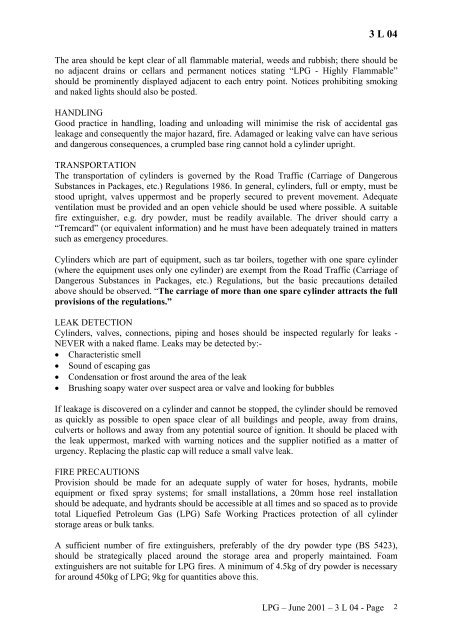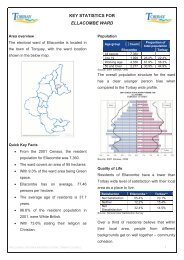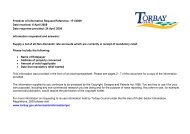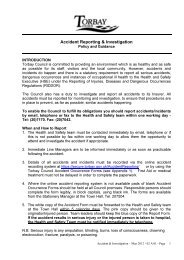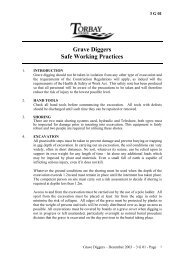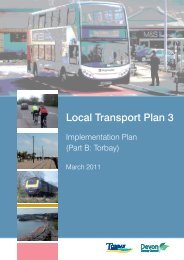Liquefied Petroleum Gas (LPG) Safe Working Practices
Liquefied Petroleum Gas (LPG) Safe Working Practices
Liquefied Petroleum Gas (LPG) Safe Working Practices
You also want an ePaper? Increase the reach of your titles
YUMPU automatically turns print PDFs into web optimized ePapers that Google loves.
3 L 04<br />
The area should be kept clear of all flammable material, weeds and rubbish; there should be<br />
no adjacent drains or cellars and permanent notices stating “<strong>LPG</strong> - Highly Flammable”<br />
should be prominently displayed adjacent to each entry point. Notices prohibiting smoking<br />
and naked lights should also be posted.<br />
HANDLING<br />
Good practice in handling, loading and unloading will minimise the risk of accidental gas<br />
leakage and consequently the major hazard, fire. Adamaged or leaking valve can have serious<br />
and dangerous consequences, a crumpled base ring cannot hold a cylinder upright.<br />
TRANSPORTATION<br />
The transportation of cylinders is governed by the Road Traffic (Carriage of Dangerous<br />
Substances in Packages, etc.) Regulations 1986. In general, cylinders, full or empty, must be<br />
stood upright, valves uppermost and be properly secured to prevent movement. Adequate<br />
ventilation must be provided and an open vehicle should be used where possible. A suitable<br />
fire extinguisher, e.g. dry powder, must be readily available. The driver should carry a<br />
“Tremcard” (or equivalent information) and he must have been adequately trained in matters<br />
such as emergency procedures.<br />
Cylinders which are part of equipment, such as tar boilers, together with one spare cylinder<br />
(where the equipment uses only one cylinder) are exempt from the Road Traffic (Carriage of<br />
Dangerous Substances in Packages, etc.) Regulations, but the basic precautions detailed<br />
above should be observed. “The carriage of more than one spare cylinder attracts the full<br />
provisions of the regulations.”<br />
LEAK DETECTION<br />
Cylinders, valves, connections, piping and hoses should be inspected regularly for leaks -<br />
NEVER with a naked flame. Leaks may be detected by:-<br />
• Characteristic smell<br />
• Sound of escaping gas<br />
• Condensation or frost around the area of the leak<br />
• Brushing soapy water over suspect area or valve and looking for bubbles<br />
If leakage is discovered on a cylinder and cannot be stopped, the cylinder should be removed<br />
as quickly as possible to open space clear of all buildings and people, away from drains,<br />
culverts or hollows and away from any potential source of ignition. It should be placed with<br />
the leak uppermost, marked with warning notices and the supplier notified as a matter of<br />
urgency. Replacing the plastic cap will reduce a small valve leak.<br />
FIRE PRECAUTIONS<br />
Provision should be made for an adequate supply of water for hoses, hydrants, mobile<br />
equipment or fixed spray systems; for small installations, a 20mm hose reel installation<br />
should be adequate, and hydrants should be accessible at all times and so spaced as to provide<br />
total <strong>Liquefied</strong> <strong>Petroleum</strong> <strong>Gas</strong> (<strong>LPG</strong>) <strong>Safe</strong> <strong>Working</strong> <strong>Practices</strong> protection of all cylinder<br />
storage areas or bulk tanks.<br />
A sufficient number of fire extinguishers, preferably of the dry powder type (BS 5423),<br />
should be strategically placed around the storage area and properly maintained. Foam<br />
extinguishers are not suitable for <strong>LPG</strong> fires. A minimum of 4.5kg of dry powder is necessary<br />
for around 450kg of <strong>LPG</strong>; 9kg for quantities above this.<br />
<strong>LPG</strong> – June 2001 – 3 L 04 - Page 2


